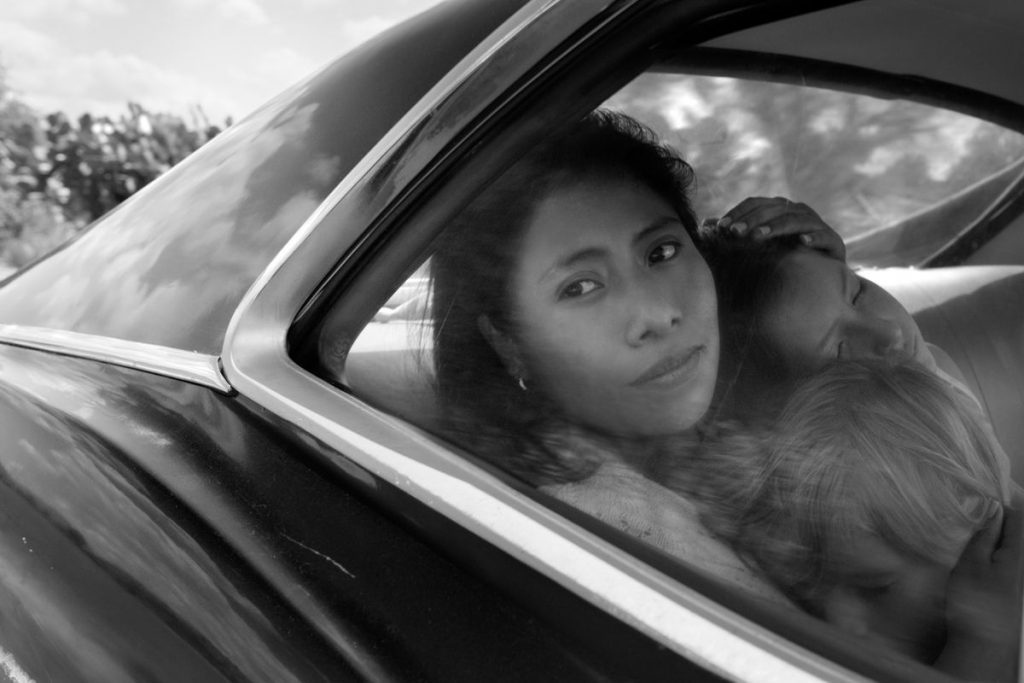Shot in black and white by one of Mexico’s premier directors, Netflix’s Roma is a visual feast and a lovingly told story.
At the center of the film, directed by Alfonso Cuaron (Y Tu Mama Tambien, Gravity and Harry Potter and the Prisoner of Azkaban) and set in Mexico City in the 1970s, is an indigenous Mixtec woman who works as a nanny for a middle-class family. Viewers follow Cleo, played by Yalitza Aparicio, through a day in her life—one in which the family she works for falls apart in the foreground while Mexico itself experiences political upheaval in the background.
The largely autobiographical plot in Roma is simple: A physician abandons his family to be with his mistress. The family fractures. Cleo helps hold it together. What is noteworthy is that Cuaron chose to tell his family’s story from Cleo’s point of view—putting an indigenous Mixtec woman at the center of his own personal narrative.

Marina de Tavia and Veronica Garcia deliver excellent performances as similarly engaging female characters in Roma—but this is Cleo’s movie. The story belongs to domestic workers, who rarely see themselves on screen. The camera is always pointed at Cleo: Viewers follow along as she moves through her day—with her washing down the driveway at the film’s opening and her workday caring for the children and doing a myriad of chores coming soon after. Alongside her, Cuaron depicts other women doing the same, breaking Cleo out of her own silo and depicting her as part of a cohort of laborers and a class of workers.
But even though Cuaron takes exceptional care with the tone and with every detail of Roma, and Aparicio plays Cleo with sensitivity and authenticity—drawing from her own experience as a domestic worker, as well as the parallel experiences of her mother—in the end her character remains enigmatic. There are many scenes in which Cleo is largely stoic and selfless. Excepting one moment when she and another Mixtec woman who works for the same family commiserate together, we never really hear Cleo’s perspective on the labor she performs or the family that employs her, and we don’t see women like her looking accurately exhausted because of those factors. While we feel intimately acquainted with Cleo, her inner life stays mostly out of reach.
I longed to watch Cleo at home. If she had returned to her village—in the film, she feels she can’t face her mother because she is pregnant and unmarried—we could have seen her within her own context.
I was struck by a scene depicting Cleo in the backseat of the family’s car, gazing out of the window after everyone a trip to the beach during which she is embraced as part of their family. The beautiful and haunting shot underscored her inscrutability: What was she thinking about? Cleo is loving, and giving, and we know this about her, but do we really know her—not through Cuaron’s eyes, but through her own?
Many films about domestic workers are told from the point of view of the elite class. Too often, the character—the person—with less social status doesn’t get to tell their story from their own point of view. That echoes the status quo in our own communities, one which Cuaron took aim at deliberately by making Cleo the focus of his own semi-autobiographical film.
“I was a white, middle-class, Mexican kid living in this bubble,” Cuaron explained to Variety about the evolving view of his own rearing by a nanny in adulthood. “I didn’t have an awareness. I [had] what your parents tell you—that you have to be nice to people who are less privileged than you and all of that—but you’re in your childhood universe.”
Cuaron went to Oaxaca to find Aparicio, returning to the place where his own nanny, a woman named Liboria “Libo” Rodriguez, hailed from. His honest acknowledgement of the socioeconomic and racial barriers that he now knows were wedged between him and the woman who helped raised him is admirable—as is his intention to bring visibility to women like her.
Roma goes as far as it can to give Cleo agency; the film places her in nearly every scene. Yet she remains anchored to the middle-class family she works for, and her story remains an extension of theirs. The affection with which Cuaron took on the challenge of telling Cleo’s story, and placing her front and center in the plot of his own life, was important. It marked a major improvement, a milestone and a breakthrough.
Still, I wish we had gotten closer. I wish we had been allowed to see further beneath the surface of Cleo, into the rich and unique world she inhabits all on her own, and outside of the demands which shape her identity when she’s on the clock.





